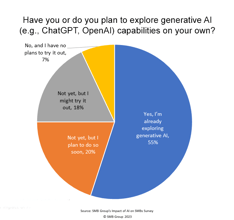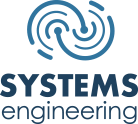The AI landscape can be likened to the untamed frontier, marked by its rapid evolution, lack of regulation, and concerns surrounding data privacy and security. Despite the risks, the productivity and innovation potential have businesses across industries embracing AI. When ChatGPT was introduced in late 2022, it quickly gained traction, with over 100 million users adopting the platform within just two months, setting a new record for user growth.
Given a rapid uptick in AI usage and the potential productivity risks it presents, President Biden recently issued an Executive Order to define some guardrails for the proliferation of AI. While this primarily applies to the technology companies building these systems, it's good guidance for what your organization will want to know about the AI they will adopt in the coming years.
 Overwhelmingly, SMBs are interested in AI and are exploring the possibilities. While AI can help small to medium-sized businesses (SMBs) maximize productivity, it's important to take a thoughtful approach to adopting AI tools to ensure they don't hinder productivity and potentially expose your sensitive or protected information.
Overwhelmingly, SMBs are interested in AI and are exploring the possibilities. While AI can help small to medium-sized businesses (SMBs) maximize productivity, it's important to take a thoughtful approach to adopting AI tools to ensure they don't hinder productivity and potentially expose your sensitive or protected information.
AI drives productivity.
AI can help save time on certain tasks and enable your team members to work more strategically. This can be especially beneficial for SMBs, which may have limited resources or employees compared to larger companies.
Here are a few examples of ways AI can drive SMB productivity:
More efficient content generation.
At Systems Engineering, a Microsoft partner, we are seeing various AI features being added to productivity apps through Microsoft Copilot, which Microsoft refers to as your everyday AI companion. You will never have to start a new Word, Excel, or PowerPoint from scratch through Microsoft Copilot. Instead, you will talk with the AI to help find relevant files, meetings, and conversations to start building the document.
On a positive note, AI and generative AI, such as ChatGPT, are already revolutionizing the way we work.
Personally, I no longer create a blog article from scratch. Instead, I feed my ideas to ChatGPT, add a few additional prompts, and I end up with the bones of a post. It saves me a significant amount of time and effort. Of course, any content generated by AI requires editing to refine, improve and tailor the content.
 Created with ChatGPT / Dall.E
Created with ChatGPT / Dall.E
Improve customer service and support.
From a customer service and support standpoint, rather than manually creating and updating tickets, which can be both distracting and time-consuming, AI can do much of this work, allowing your technician to focus on the customer. The AI can look at ticket trends and suggest solutions or escalate the ticket if there is a correlation across multiple tickets. This enables service and support teams to quickly resolve tickets, work more effectively, and address common challenges customers are facing. In fact, research from the National Bureau of Economic Research found that generative AI increased customer support agent productivity by 14%. At Systems Engineering, we process well over a hundred thousand tickets per year. While we have a data warehouse and use Microsoft Power BI to report on KPIs and perform other analytical tasks, AI will help drive consistency in the ticket data and more readily surface trends we might otherwise miss.
Automate sales quotes
AI can also be used to build sales quotes based on your customers' specific needs and historical data. If a customer sends an email inquiring about a specific product or service, an AI tool can automatically read the email, look at previous quotes your team has shared with customers, and pre-build a quote for approval by the sales representative; saving them hours of work every month preparing routine quotes. An AI tool can build the quote faster than your sales team member may finish reading the email, giving sales teams more time to focus on building customer relationships.
AI may hinder productivity.
While AI can drive productivity gains in your SMB, it may also have a negative impact on productivity if you don't have a strategy in place to effectively and securely implement AI tools. Some drawbacks of AI from a productivity standpoint include:
- Unfamiliarity and distraction from AI tools: Staff may spend a significant amount of time experimenting with different AI tools, taking time away from their day-to-day responsibilities with the potential for data loss.
- Over-reliance on AI tools: Common sense still matters, and having a critical eye for when the AI tool just does not make sense will save you from some serious mistakes.
- Inconsistent adoption: As is the case with any new technology, some employees may be eager to adopt AI, while others may be hesitant. This can lead to inconsistent processes across the business.
To ensure AI maximizes productivity, develop and implement an Acceptable Use Policy for AI and schedule training and security awareness sessions for your employees. According to research from ISACA, 28% of organizations surveyed say their companies expressly permit the use of generative AI, 10% say a formal comprehensive policy is in place, and more than one in four say no policy exists and have no plan for one.
It is equally crucial to ensure that your data is accurate, complete, and has the appropriate permissions for access. The output from an AI tool parsing your data is only as good as the data you put in. There is a risk of having staff finding your sensitive company data if the right permissions are not in place.
Have a plan in place to successfully adopt AI.
We are still in the early stages of learning about and adopting AI. To drive productivity and business benefits, it's important to have a plan in place for how, when, and what your business will adopt AI. A key part of this process is thinking through the benefits and risks before implementing a solution that reaches deep into your organization.
AI is already in your SMB. You are being exposed through the applications you use to run your business, whether it's Microsoft 365 or a specific line of business application. It's wise to stay current on how AI is and will permeate your SMB. Start by asking key vendors where AI is on their roadmap and how it will work. If these AI tools impact how you train, evaluate, or hire employees, for example, ensure you are comfortable that the vendor has addressed any biases inherent in their code.
AI has emerged as a leading force in the digital transformation revolution, where you can get even deeper insights into your products, services, and client experiences. At its core, AI relies on good data. Consider auditing your data for quality and security before you embark on a major AI initiative. If you don't have the in-house skills to review your data structure both on-premises and in the cloud, we can help. Systems Engineering provides planning, design, and implementation of support needed to embrace standard business intelligence before jumping into AI.
This is part one of a two-part series on the advantages and drawbacks of AI, and how to successfully implement AI. Part two will focus specifically on the security implications of AI and best practices to minimize risks.
If you are a Systems Engineering client and have questions about this blog, please reach out to your Account Manager. Others, please connect with us at info@systemsengineering.com or call 888.624.6737.
 Mark Benton is the Director of Product Management at Systems Engineering with 30+ years of experience in Information Technology. Mark is responsible for overseeing the onboarding of new products and services for Systems Engineering and its customers.
Mark Benton is the Director of Product Management at Systems Engineering with 30+ years of experience in Information Technology. Mark is responsible for overseeing the onboarding of new products and services for Systems Engineering and its customers.






